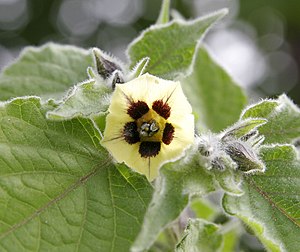Physalis pubescens
| Physalis pubescens | ||||||||||||
|---|---|---|---|---|---|---|---|---|---|---|---|---|

Physalis pubescens |
||||||||||||
| Systematics | ||||||||||||
|
||||||||||||
| Scientific name | ||||||||||||
| Physalis pubescens | ||||||||||||
| L. |
Physalis pubescens is a plant type from the genus of jujubes ( Physalis ) in the family of the nightshade family (Solanaceae).
description
Physalis pubescens is an annual or biennial , sometimes heavily branched, herbaceous plant that reaches heights of between 10 and 150 cm. The hairs on the stems are fine and variable, consisting of glandular or non-glandular, multicellular trichomes up to 3 mm in length.
The leaves are usually hairy tomentose, and 3 to 17 cm long. The leaf stalks are 1.5 to 7.0 cm long, the leaf blades are usually 2 to 10 cm long and 1 to 7 cm wide. Their shape is egg-shaped to triangular, tapering to a point towards the front and blunt to cut off at the base. If the halves of the leaf base are inclined, then they are only a maximum of 3 cm from each other. The leaf margin is irregularly serrated to almost entire.
The flowers are on 2 to 7 mm long peduncles . The calyx is tomentose and covered with 1.5 to 3.0 mm long calyx lobes during flowering. The crown is colored yellow and measures 0.9 to 1.5 cm in diameter. The petals are marked with five dark purple marks and finely haired at the point of attachment of the stamens . Both stamens and anthers are usually purple or blue in color, only a few copies are yellow. The anthers reach a length of up to 2 mm.
On the fruit, the stalk extends to a length of 5 to 10 mm. The strongly enlarging calyx is strongly five-angled and 1.2 to 3.0 cm long and 1.8 to 2.5 cm wide, always longer than wide and is completely hairy with multicellular trichomes. The calyx surrounds a berry with a diameter of about 1 cm, which is green-purple to yellow in color when ripe. It contains a large number of seeds with a small pitted surface and a diameter of about 1.5 mm.
The number of chromosomes is 2n = 24 or 48.
Distribution and locations
The species is distributed from the northeast of the USA along the Atlantic coast via Mexico to Argentina and the West Indies . It is a common weed, which is mostly found at altitudes between 0 and 900 m, but also grows in Colombia at altitudes of up to 2700 m. The species prefers sandy soils near rivers.
literature
- Mahinda Martinez: Revision of Physalis Section Epeteiorhiza (Solanaceae) . In: Anales del Instituto de Biología Universidad Nacional Autónoma de México , Series Botánica, Volume 69, Number 2, 1998. pp. 71-117.
Individual evidence
- ↑ Physalis pubescens at Tropicos.org. In: IPCN Chromosome Reports . Missouri Botanical Garden, St. Louis
